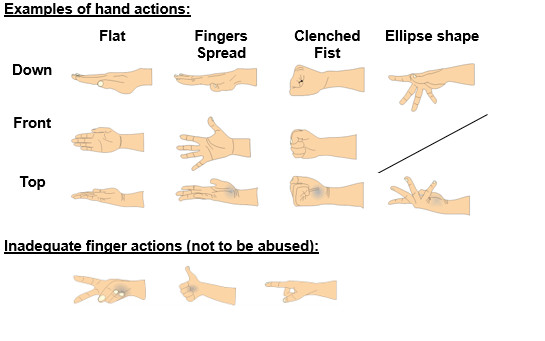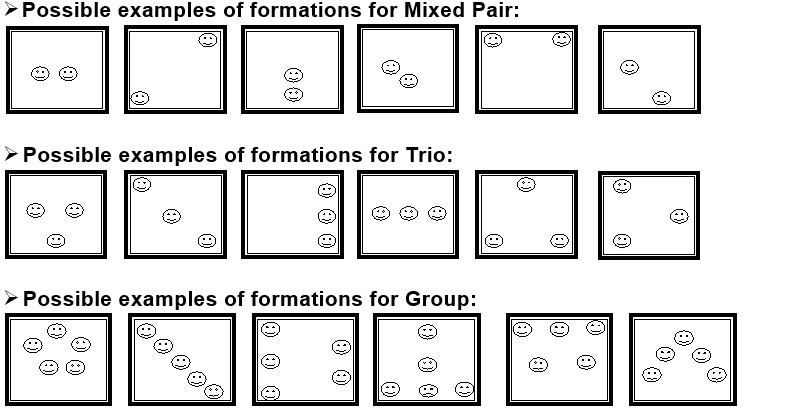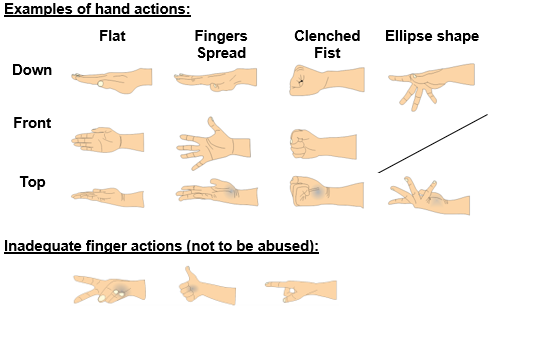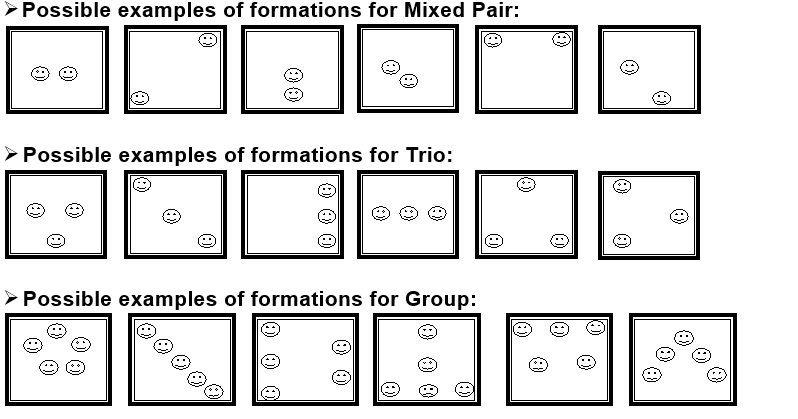1. MUSIC (Max. 2.0 points)
The routine must be performed, in its entirety, to music. Any style of music adapted for Aerobic Gymnastics can be used. That means that the music used by the gymnasts should reflect and provide the main characteristics of aerobic gymnastics, and the specificity of the sport and its nature.
1.1 Selection / Composition / Editing Quality (2.0 pts)
<Selection>
<Composition (structure)>
< Editing Quality >
1.1 Selection / Composition / Editing Quality (2.0 pts)
<Selection>
- A good musical selection will help establish the structure and pace, as well as the theme of the exercise. It will support and highlight the performance. It must also be used to inspire the overall choreography and contribute to the style and quality of the choreography, as well as to the expression of the gymnasts.
- Every routine should have a story / style and the selected music must represent the story / style the gymnast and the choreographer want to transmit.
- The chosen music must give an advantage to the individual competitor’s characteristics and style. The music must be suitable for the category and enhance the routine.
- There is both male and female performer/s as well as the different ages of the competitors. To be an individual competitor or a MP, or a TR or a GR are all different: all the music does not fit with all the categories and ages. These differences should be reflected in the chosen music.
- Some music themes can be used by man, woman, MP, TR or GR. The way they use and interpret the music will determine and show if the selection was appropriate and helped to highlight the performance.
<Composition (structure)>
- The music used by the performers should respect the characteristics of aerobic gymnastics and its nature.
- It should be dynamic, varied (not monotonous), rhythmical, original (creative), countable (with beats or not, but possible to identify the appropriate timing/tempo for aerobic gymnastics, with a rhythm which can be counted).
- Well balanced between edited beats and original beats and melody of the music.
< Editing Quality >
- Technically the music must be perfect, can be the original or can be a version arranged, without abusing extra accents and without excessive use of rhythmical base used as background (too loud/louder than melody); the melody of the song should be audible over the base or background added and not vice versa.
- The recording and mixing of music must be of professional quality and well-integrated, and without any abrupt cuts, giving a sense of one music piece (noise vs. music).
- It should flow, with a clear start and clear ending (fade out is not recommended), with well-integrated sound effects (if they are included), respecting the musical phrases and melody.
- The music used has a structure:
- Melody / Story / Style of music (eg; salsa, tango, folk, disco, rock, joyful, dramatic, movie soundtracks etc.)
- Opening, ending, phrases, accents, beats
- Rhythm, tempo / pace
- Themes or musical pieces (one or more, like a medley)
- It is expected that the performers select music with a correct structure and with different parts of the same music or different, in order to avoid monotony of the music used.
- In order to have the appropriated sets of AMP sequences, it is recommended to use music with 8-counts structure which will help the recognition of AMP sequences.
- Rhythm of the music should not be too slow or too fast (recommendation 145-160 BPM) giving advantage to the gymnast to move with the music.
MUSIC / SUMMARY
| Criteria | Main Points | Deviation from Excellent (examples) |
| 1.1 Selection / Composition / Editing Quality |
|
|
2. AEROBIC CONTENT (Max. 2.0 points)
In the Aerobic Content, we evaluate the Aerobic Movement Patterns (AMP) throughout the routine, with adequate intensity. The series of AMP are the foundation (bases) of Aerobic Gymnastics routines.
The quality (perfect technique) of the AMP is very important in order to be recognizable as a clear sequence.
AMP must include variations of steps with arm movements, to produce combinations with body coordination and must be recognizable as continuous movement patterns.
AMP Sequence means a complete 8-count of movements with aerobic movement patterns performed in a musical phrase (from the 1st beat to the 8th beat) in order to stay with the music. If the AMP is performed for less than 8 counts, it will not be recognized as an AMP sequence, and considered as linking movements.
The AMP sequences should provide the adequate intensity for the aerobic gymnastics’ routines.
The quality (perfect technique) of the AMP is very important in order to be recognizable as a clear sequence.
AMP must include variations of steps with arm movements, to produce combinations with body coordination and must be recognizable as continuous movement patterns.
AMP Sequence means a complete 8-count of movements with aerobic movement patterns performed in a musical phrase (from the 1st beat to the 8th beat) in order to stay with the music. If the AMP is performed for less than 8 counts, it will not be recognized as an AMP sequence, and considered as linking movements.
The AMP sequences should provide the adequate intensity for the aerobic gymnastics’ routines.
2.1 Quantity – Amount of AMP (1.0 pt)
<SHORTHAND FOR AMP SEQUENCE (set)>
- Throughout the routine, AMP Sequences must be performed. This means, other than Difficulty Elements, Transitions/Linking and Partnerships (physical interaction / collaborations), the routine should provide a sufficient amount of complete set of AMP sequence.
- One set of AMP = 8-count (eg. 3-sets=3x8)
- The Block of AMP sets means consecutive and clear AMP, which shows the identity of our sport using the traditional aerobic steps with constant rebound and performed without choreographic jumps (e.g.: air jack).
| Category | Minimum AMP Sets | Including Consecutive AMP Block |
| IM / IW | 8 sets | 1 block (3 AMP sets) |
| MP / TR / GR | 9 sets | 1 block (4 AMP sets) |
<SHORTHAND FOR AMP SEQUENCE (set)>
- for each 8-count set
- If there are no 8/9 complete AMP sets in the routine, the A-Jury immediately reduce -0,2 / each missing AMP set from the Quantity factor.
- If there is no Block (3/4 consecutive AMP sets), the A-Jury immediately reduce -0,5 from the Quantity factor.
2.2 Quality – Variety (1.0 pt)
Variety AMP sequences can be achieved by:
Examples of variations of 7 basic steps.
- AMP is the base of the Aerobic Gymnastics and main (principal) characteristic (Sports Specific).
- The specific technique of the basic steps is described in the Appendix 3.
- The leg movements must show the correct technique (rebound) of Aerobic Basic Steps with coordination and variety.
- The arm movements must be performed with quality showing precision and fluency. Trajectory from one position to another should be natural with various symmetrical/asymmetrical movements with possibility to change the rhythm.
Variety AMP sequences can be achieved by:
- Involving more body parts (head, shoulders, etc.)
- Using different joint actions / planes / range of motion / lever length
- Using symmetric / asymmetric moves
- Using different rhythm
- Using both arms simultaneously
- Speed of motion
- Orientation changing
- Formation changing
- Travelling with AMP sequences
- Throughout the routine, AMP Sequences must show variety without repetition avoiding same or similar type of Sequences during the routine. All basic steps must be used throughout the routine.
- The AMP sequences must represent the style of the music. Combine: basic aerobic steps, dance steps, choreographic jumps (except for the AMP block), body expressions etc. without repetition.
- The AMP Block must be different from the rest of sequences, without choreographic jumps (eagle jump, deer jump, etc). The Block must have traditional aerobic movements without repetitive combination and to show body coordination that produces complex and variety of sequences in order to avoid monotonous and stationary (staying in same place).
- For MP/TR/GR; This Block must be performed close to each other (short distance) as a unit with perfect synchronization, possibly using orientation, positioning, formation changes and traveling.
Examples of variations of 7 basic steps.
- March: angle, height, speed, rhythm change, or directions. (i.e. V-step, turn-step, two-steps, box-step)
- Jog: angle, speed, rhythm change, and directions
- Knee lift: planes, angle, speed, rhythm change, in High or Low Impact
- Kick: planes, height, speed, rhythm change, in High or Low Impact and directions. (i.e. middle kick, high kick, and vertical kick)
- Jumping Jack: angle at hips and knees speed, rhythm change, in High or Low Impact (squat)
- Lunge: planes, angle, speed, rhythm change, in High or Low Impact
- Skip: planes, angle and directions, speed, rhythm change, in High or Low Impact.
Examples of variation factors for arm movements:
(It is not necessary to use all of the examples)
(It is not necessary to use all of the examples)
- Use of symmetrical and asymmetrical moves
- Use of different height (high, low, diagonal)
- Use of different length (bend, extend)
- Use of linear and circular movements
- Use of different rhythm / speed
- Use of different planes (frontal, transverse, sagittal)
- Use of different actions (flexion, extension, abduction, adduction, pronation, supination, etc.)
- Use of different hand positions (palm open, palm closed, fist, etc). The abuse of finger movements is not keeping with the direction of aerobic gymnastics discipline.
- Variation of arm movements does not mean high frequency.
- Arm movements can be in different ranges of motion some of them can be more “delicate” as long as they have a meaning with the idea of the choreography, with the style and the category of the competitor.

AEROBIC CONTENT / SUMMARY
| Criteria | Main Points | Deviation from Excellent (examples) |
| 2.1 Amount of AMP |
|
|
| 2.2 Variety |
|
|
3. GENERAL CONTENT (Max. 2.0 points)
The general content of the routines are:
IM/IW: The routine must be balanced in complexity factor. Showing different length of transitions, using different physical capacities and different forms without repetition of movements in the routine.
MP/TR/GR: Must perform minimum of 3 collaborations required without repetition. If less than 3 collaborations, the A-Jury reduces -0.2 from Complexity/Variety. The rest of the transitions/links/partnerships must be balanced, meaningful and give advantage to the routine. This includes Acrobatic elements.
If different collaborations are shown at the same time (starting at the same time), it is counted as 1 collaboration.
<SHORTHAND FOR GENERAL CONTENT>
In order to evaluate the General Content, will take in consideration the movements as a whole, as a unit (performed in the same period of time):
<Example of Shorthand (IW) >
G (intro) A E G E + E E G A A Acro + E
G A A A E A G E G E G A A
G E G (ending)
- Transitions/ Links
- Partnerships/ Collaborations
- Acrobatic elements
- The movements are complex when many body parts are involved simultaneously.
- A movement is complex when:
- It requires coordination
- It needs technical ability and physical capacity
- It is dynamic
- It has more fluidity
- It is unpredictable.
- To evaluate the variety of the general contents, the A-Jury will take into consideration that all of these movements must be WITHOUT REPETITION or reiteration of the same or similar types of movements.
- Excellent routines must show different types of movements. All of them should include different actions, different forms and different physical capacities during the performance of the transitions/linking and partnership/collaborations. General contents (G) have to be meaningful, fit with the music or show unique movements inside the routine.
- If General contents are significantly repetitive in the routine, the A-Jury reduces -0.2 with different criteria from Complexity/Variety factor.
- The connection from/to movements must be smooth and fluent. All the movements presented in the routine, must be linked without any unnecessary pauses showing agility.
- Excessive pauses in general content will decrease the fluency of the routine and do not match with the characteristics and nature of Aerobic Gymnastics discipline.
IM/IW: The routine must be balanced in complexity factor. Showing different length of transitions, using different physical capacities and different forms without repetition of movements in the routine.
MP/TR/GR: Must perform minimum of 3 collaborations required without repetition. If less than 3 collaborations, the A-Jury reduces -0.2 from Complexity/Variety. The rest of the transitions/links/partnerships must be balanced, meaningful and give advantage to the routine. This includes Acrobatic elements.
If different collaborations are shown at the same time (starting at the same time), it is counted as 1 collaboration.
<SHORTHAND FOR GENERAL CONTENT>
In order to evaluate the General Content, will take in consideration the movements as a whole, as a unit (performed in the same period of time):
- for each movement or a block of movements (1 unit).
<Example of Shorthand (IW) >
G (intro) A E G E + E E G A A Acro + E
G A A A E A G E G E G A A
G E G (ending)
3.2 Space (1.0 pt)
<Use of the competition area and formation>
The competition area must be effectively used throughout the routine with well-balanced structure of the choreography, not only the corners and the center of the competition space but all areas of the competition space.
<Use of the competition area and formation>
- Throughout the routine, travelling must be shown in all directions (forward, backward, laterally, diagonally and circular) and long and short distances, without repetition of similar traces/tracks.
- In GR category, only covering the surface is not enough to fulfill the criteria of use of the space; they must travel using the AMP sequences in all the directions and distances.
The competition area must be effectively used throughout the routine with well-balanced structure of the choreography, not only the corners and the center of the competition space but all areas of the competition space.

<Formation changes>
- Formations include positions / positioning of the partners and the way in which they change positions to another formation or in the same formation while they are performing AMP or other movements, and distances between the competitors.
- Throughout the routine, different formations and different positions of the team mates must be shown (including distances between gymnasts far versus close)
- The formation changes should be fluent.

<Routine components>
- All three levels (floor-work, standing, airborne) of the competition space must be used. Not more than 32 counts on the floor or in the surface without change the level are recommended.
- All the components of the routine must be properly distributed in both the competition area and the length of the routine.
- The movements must be placed in a balanced way in the competition space (this means for example if there is floor work in the routine, should be placed in different zones). This applies for all the routine components.
<Routine components>
- All three levels (floor-work, standing, airborne) of the competition space must be used. Not more than 32 counts on the floor or in the surface without change the level are recommended.
- All the components of the routine must be properly distributed in both the competition area and the length of the routine.
- The movements must be placed in a balanced way in the competition space (this means for example if there is floor work in the routine, should be placed in different zones). This applies for all the routine components.
GENERAL CONTENT / SUMMARY
| Criteria | Main Points | Deviation from Excellent (examples) |
| 3.1 Complexity / Variety |
|
|
| 3.2 Space |
|
|
4. ARTISTIC ROUTINE (Max. 2.0 points)
Unique / memorable routines include details to enhance the quality of the routine.
All the components of the choreography must fit perfectly together in order to transform a sport exercise into an artistic performance, with creative and unique characteristics by respecting the specificity of Aerobic Gymnastics (clean sport like manner).
Originality / Creativity of the routines, including not only the theme of the exercise according to the music selected but also the innovation and uniqueness in other movements (partnerships, transitions, etc.) performing with natural and genuine expression.
The Opening of the choreography starts with the first movement of the competitor(s). The Opening of the choreography means; any other movements rather than elements.
Each routine should include an “Opening” (“Intro”) (for example: 4-8 counts with or without movements) which fit with the music to develop the theme/style of the routine.
A-Jury evaluates the routine as a whole. If there is no intro or it ends directly with an element, artistic routine criteria will not be very good or excellent.
All the components of the choreography must fit perfectly together in order to transform a sport exercise into an artistic performance, with creative and unique characteristics by respecting the specificity of Aerobic Gymnastics (clean sport like manner).
Originality / Creativity of the routines, including not only the theme of the exercise according to the music selected but also the innovation and uniqueness in other movements (partnerships, transitions, etc.) performing with natural and genuine expression.
The Opening of the choreography starts with the first movement of the competitor(s). The Opening of the choreography means; any other movements rather than elements.
Each routine should include an “Opening” (“Intro”) (for example: 4-8 counts with or without movements) which fit with the music to develop the theme/style of the routine.
A-Jury evaluates the routine as a whole. If there is no intro or it ends directly with an element, artistic routine criteria will not be very good or excellent.
4.1 Construction of the Choreography (1.0 pt)
- The routine should be like a small piece of art, which should give a memorable impression, based on the characteristics of Aerobic Gymnastics.
- Memorable routines are when all the routine components match perfectly with the music and the theme/style of the exercise in sport manner, captivating and impressing the audience.
- Choreography should present new, creative and original movements (collaborations, transitions, etc)
- Unique movements will emphasize the Artistry of the choreography.
- If routine starts/ends directly with an element, immediately reduce -0.2 / each.
- Musicality is the ability of the performer(s) to interpret music and to demonstrate not only its rhythm and speed, but also show its flow, intensity and passion within the physical performance.
- The routine must be performed entirely to music. Choreography utilizes the idea given by the music.
- There must be strong cohesion between the overall performance (movements) and the choice of music. All movements must fit perfectly with the chosen music. In the creative process, the choreographer creates the movements to that specific music and for that specific competitor(s).
- The AMP sequences also must have high correlations with the theme and the style of the music. There must be a reason to include that arm(s) movement, without losing the style of the choreography. The use of the head and the torso during the execution of the AMP may be another possibility to include in the choreography.
- The routine must harmonize with the style of the music. The style of the music should fit with the characteristics and style of the movements presented by the performers respecting the musical phrases. The competitor should be able to express with his/her movements and his/her body language the music played.
- The choreography must follow the rhythm, the beats, the musical phrases and the melody. Inability to move with the music will result in BGM (back ground music).
ARTISTIC ROUTINE / SUMMARY
| Criteria | Main Points | Deviation from Excellent (examples) |
| 4.1 Construction of the Choreography |
|
|
| 4.2 Musicality |
|
5. ARTISTIC PRESENTATION (Max. 2.0 points)
Gymnasts have to transform the composition from a well-structured routine into an artistic performance, using his/her personality, unique style and excellent way of using the music.
Gymnasts must represent their own gender and age on the stage.
In MP/TR/GR, they work as an unit, using collaborations/partnerships to show the beauty of the teamwork.
Through expression, transform movements in both gymnastics’ elements and choreography, into a singular artistic whole.
They combine the elements of the art and the sport of Aerobic Gymnastics into one attractive message towards the audience, in sport manner.
Gymnasts must, therefore, demonstrate Musicality, Expression and Partnership in addition to the impeccable execution.
The quality (mastery/perfection) of the routine is essential, not only by showing high degree of perfect execution in all difficulty and acrobatic elements, but also in choreography movements (AMP, Transition/linking, partnerships, etc.), with the correct technique of all movements.
5.1 Presentation / Quality of the movements (2.0 pts)
Gymnasts must represent their own gender and age on the stage.
In MP/TR/GR, they work as an unit, using collaborations/partnerships to show the beauty of the teamwork.
Through expression, transform movements in both gymnastics’ elements and choreography, into a singular artistic whole.
They combine the elements of the art and the sport of Aerobic Gymnastics into one attractive message towards the audience, in sport manner.
Gymnasts must, therefore, demonstrate Musicality, Expression and Partnership in addition to the impeccable execution.
The quality (mastery/perfection) of the routine is essential, not only by showing high degree of perfect execution in all difficulty and acrobatic elements, but also in choreography movements (AMP, Transition/linking, partnerships, etc.), with the correct technique of all movements.
5.1 Presentation / Quality of the movements (2.0 pts)
- How a gymnast or group of gymnasts generally present themselves to the jury and the public
- Sharing their own emotions during the routine with the audience with expressions, quality movements and fluidity
- Attitude and range of emotion that is expressed not only on the faces, but with the bodies of the gymnasts
- For MP/TR/GR; The competitors must demonstrate that they are a team as a unit and therefore show the advantages of being more than one person. This includes the working relationship between the members. Movements must be distinctive respecting the gender (woman=feminine, man=masculine).
- When men and women are together in the same category (MP/TR/GR), movements which respect the gender differences are not considered as synchronization mistake.
ARTISTIC PRESENTATION / SUMMARY
| Criteria | Main Points | Deviation from Excellent (examples) |
| 5.1 Presentation / Quality of the movements |
|
|








